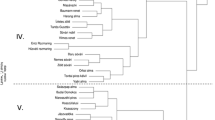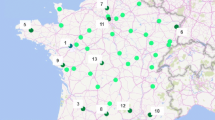Abstract
In fruit trees, understanding genetic determinisms of architectural traits is considered as a promising manner to control vegetative development and yield regularity. In this context, our study aimed to classify 2-year-old apple hybrids on the basis of their architectural traits. From a fine phenotyping, trees were described as tree graphs, including topological and geometric information. To evaluate the similarity between trees, comparison methods based on edit operations (substitution, insertion and deletion) were carried out. Distance between two tree graphs was computed by minimising the sum of the costs of the edit operations applied to transform one tree into another. Two algorithms for the comparison of unordered and partially ordered tree graphs were applied to a sub-sample of the population, taking into account several geometric attributes. For each comparison, a dissimilarity matrix was computed, and subsequently trees were clustered. A local interpretation of the matched entities was proposed through schematic representations of the trees, and similarities between trees were analysed within and between clusters. The tree graphs, both unordered or partially ordered and whether the attributes were considered or not, were grouped, by clustering, according to the number of entities per tree. The robustness of the unordered comparison was demonstrated by its application to the whole population, since it provided results similar to those obtained on the sub-sample. Further developments towards a higher relative weight of geometric versus topological information are discussed in the perspective to define an architectural ideotype in apple.




Similar content being viewed by others
References
Alméras T, Costes E, Salles JC (2004) Identification of biomechanical factors involved in stem shape variability between apricot tree varieties. Ann Bot 93:455–468
Beavis WD (1998) QTL analyses: power, precision, and accuracy. In: Paterson AH (ed) Molecular dissection of complex traits. CRC, New York
Costes E, Guédon Y (2002) Modelling branching patterns in 1-year-old trunks of six apple cultivars. Ann Bot 89:513–524
De Wit I, Cook NC, Keulemans J (2004) Characterization of tree architecture in two-year-old apple seedling populations of different progenies with a common columnar gene parent. Acta Hortic 663:363–368
Dickman DI, Gold MA, Flore JA (1994) The ideotype concept and the genetic improvement of tree crops. Plant Breed Rev 12:163–193
Donald CM (1968) The breading of crop ideotypes. Euphytica 17:385–403
Edelin C (1991) Nouvelles données sur l’architecture des arbres sympodiaux: le concept de plan d’organisation. In: Edelin C (ed) L’Arbre, Biologie et développement. Naturalia Monspeliensia, Montpellier
Ferraro P, Godin C (2000) A distance measure between plant architectures. Ann For Sci 57:445–461
Gallais A (1989) Théorie de la sélection en amélioration des plantes. Masson, Paris
Godin C, Caraglio Y (1998) A multiscale model of plant topological structures. J Theor Biol 191:1–46
Godin C, Costes E, Sinoquet H (1999) A method for describing plant architecture which integrates topology and geometry. Ann Bot 84:343–357
Godin C, Guédon Y (2003) AMAPmod: exploring and modeling plant architecture. Version 2.1.16. CIRAD/INRA UMR Modélisation des plantes, Montpellier
Godin C, Guédon Y, Costes E et al (1997) Measuring and analyzing plants with the AMAPmod software. In: Michalewicz M (ed) Advances in computational life science. CSIRO, Australia
Guédon Y, Heuret P, Costes E (2003) Comparison methods for branching and axillary flowering sequences. J Theor Biol 225:301–325
Laurens F (1999) Review of the current apple breeding programmes in the world: objectives for scion cultivar improvement. Acta Hortic 484:163–170
Laurens F, Audergon J, Claverie J et al (2000) Integration of architectural types in French programmes of ligneous fruit species genetic improvement. Fruits 55:141–152
Lauri PE, Costes E (2004) Progress in whole tree architectural studies for apple cultivar characterization at INRA, France—contribution to the ideotype approach. Acta Hortic 663:357–362
Lauri PE, Terouanne E, Lespinasse JM et al (1995) Genotypic differences in the axillary bud growth and fruiting pattern of apple fruiting branches over several years—an approach to regulation of fruit bearing. Sci Hortic 64:265–281
Lespinasse JM (1977) La conduite du pommier: types de fructification, incidence sur la conduite de l’arbre. INVUFLEC, Paris
Lespinasse Y (1992) Le pommier. In: Gallais A, Bannerot H (eds) Amélioration des espèces végétales cultivées—objectifs et critères de sélection. INRA Editions, Paris
Renton M, Guédon Y, Godin C et al (2006) Similarities and gradients in growth unit branching patterns during ontogeny in ‘Fuji’ apple trees: a stochastic approach. J Exp Bot 57:3131–3143
SAS Institute Inc (2000) SAS user’s guide: statistics. SAS Institute Inc., Cary, NC, USA
Segura V, Cilas C, Laurens F et al (2006) Phenotyping progenies for complex architectural traits: a strategy for 1-year-old apple trees (Malus x domestica Borkh.). Tree Genet Genome 2:140–151
Segura V, Denancé C, Durel CE et al (2007) Wide range QTL analysis for complex architectural traits in a 1-year-old apple progeny. Genome 50:159–171
Ward JH (1963) Hierachical grouping to optimize an objective function. J Am Stat Assoc 58:236–244
Zhang K (1996) A constrained edit distance between unordered labeled trees. Algorithmica 15:205–222
Acknowledgements
This research was partly funded by a Ph.D. grant from ‘ACI Arborescences’ project, allocated to A. Ouangraoua, and a Ph.D. grant from INRA Genetic and Breeding Department and Languedoc-Roussillon Region, allocated to V. Segura. We are grateful to all the members of the ‘ACI Arborescences’ project for their fruitful discussions. We acknowledge G. Garcia and S. Feral for their contribution to field measurements and technical assistance in the orchard. We also acknowledge C. Smith for improving the English.
Author information
Authors and Affiliations
Corresponding author
Rights and permissions
About this article
Cite this article
Segura, V., Ouangraoua, A., Ferraro, P. et al. Comparison of tree architecture using tree edit distances: application to 2-year-old apple hybrids. Euphytica 161, 155–164 (2008). https://doi.org/10.1007/s10681-007-9430-6
Received:
Accepted:
Published:
Issue Date:
DOI: https://doi.org/10.1007/s10681-007-9430-6




